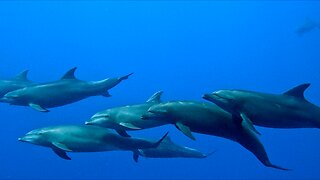Premium Only Content

Humpback whale pod nearly collides with swimmers in Tonga
Humpback whales are one of the most massive and beautiful creatures on earth. They come to Tonga in July through October to mate and to have their babies in a safe environment where there are no predators. The conditions are ideal and the mothers feed their calves massive amounts of milk so they will grow rapidly. They will need their size and strength for the long journey to northern waters where they feed.
Bulls, or male humpbacks, also come to Tonga and they will follow females and calves for weeks, providing an escort and added safety for the pair. But they are also waiting and hoping for a chance to mate with the females. Their protectiveness is only partially out of desire to keep her and the calf safe. It is also motivated by a desire for an opportunity to reproduce.
When a female humpback is ready to mate, males will follow and even chase her, competing with each other for the rights. These pursuits often involve six or seven males swimming at full speed, acting very aggressively as they thrash and bump each other. Occasionally, they inflict serious injury on each other in the process. They are 60 ton animals and their hormones are raging. They have little restraint and a lot of drive as they struggle ferociously to impress the female. These behaviors are thrilling and fascinating to watch from a boat.
These swimmers are enjoying a snorkel in the shallow waters near an island close to Vavaèu in the Tongan waters. They have been watching the whales from the boat and looking for a chance to actually swim with a whale. Now, during a break for lunch, they are looking at coral and fish along the reef. It is the last place you would expect to see a humpback whale, or a pod of fast moving whales.
But the whales came crashing through like a herd of wild elephants. The female led the pack and nearly struck two of the swimmers. They saw her coming in time to swim backwards and out of the way. The laws here, as well as common sense, require that people avoid getting closer that 5m or 15 feet to the whales. Ethical guides such as the one on this tour will strictly enforce these rules and make sure that guests understand. But it is impossible to control the behavior of the whales and it is possible that they will not respect the same distance.
The swimmer filming this incredible event looked to his left to see a 55 foot humpback bearing down on him in water that was barely deep enough for the whale to squeeze through. He was floating at the surface, about 15 feet off the coral and there was nothing to do but tuck in his arms and legs. The whale seemed to realize he was about to collide with a helpless person and he slowed abruptly, twisting and almost scraping the coral with his belly. The bull swam directly under him and missed by inches.
This gentle giant actually made very slow and careful strokes with his tail until he was clear of the swimmer. He then accelerated with much bigger tail strokes and rapidly took off after the pack. A total of seven whales barged past these surprised swimmers.
These incredible creatures have much greater intelligence and compassion than we have ever given them credit for. Sadly, some countries are still hunting and killing these magnificent animals. The Tongan people can teach us a lot about respecting the whales and the environment. The humpbacks also provide the Tongans with much needed revenue through tourism as people travel here to experience their beauty in their natural world. To lose these whales would be beyond tragic.
-
 1:55
1:55
WildCreatures
13 days ago $0.93 earnedDolphins and Whale Shark at the same Time Make an Unforgettable Scuba Encounter
3.01K1 -
 59:01
59:01
The Liberty Lobbyist
5 hours ago"We Only Have NOW To Make a Difference"
34.2K2 -
 4:16:41
4:16:41
CatboyKami
7 hours agoStalker 2 Blind playthrough pt1
33.9K2 -
 1:06:27
1:06:27
Russell Brand
7 hours agoNeil Oliver on the Rise of Independent Media, Cultural Awakening & Fighting Centralized Power –SF498
206K270 -
 1:39:14
1:39:14
vivafrei
7 hours agoSoros Karma in New York! Tammy Duckwarth Spreads LIES About Tulsi Gabbard! Pennsylvania FLIPS & MORE
100K74 -
 1:57:36
1:57:36
The Charlie Kirk Show
6 hours agoInside the Transition + The Bathroom Battle + Ban Pharma Ads? | Rep. Mace, Tucker, Carr | 11.21.24
150K66 -
 59:20
59:20
The Dan Bongino Show
9 hours agoBitter CNN Goes After Me (Ep. 2375) - 11/21/2024
957K4.02K -
 57:28
57:28
TheMonicaCrowleyPodcast
4 hours agoThe Monica Crowley Podcast: Mandate into Action
27.5K2 -
 1:02:09
1:02:09
TheAlecLaceShow
7 hours agoGuests: Alex Marlow & Terry Schilling | Justice For Laken Riley | Russian ICBM | The Alec Lace Show
38.5K8 -
 1:51:15
1:51:15
Danny Haiphong
6 hours ago $13.22 earnedMARK SLEBODA & SCOTT RITTER: NATO ATTACKS RUSSIA, PUTIN FIRES ICBM WARNING SHOT AT UKRAINE—WW3 NEXT?
82.4K26